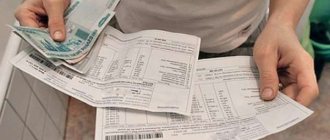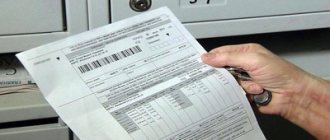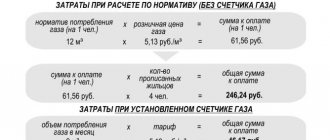Author of the article
Yulia Kuprina
Certified lawyer. Total work experience in the specialty is 13 years.
By law, the installation of IMU (individual metering devices) is mandatory when there are no design difficulties. It happens that this cannot be done objectively, for example, due to the dilapidation of water pipes.
There are no fines for missing meters. But the owner of the apartment is “punished” with increased rent. If there are no mechanical obstacles to installing an IPU, but the owner refuses to install them, then payment for used water is determined using an increased coefficient. The figure turns out to be quite impressive.
The standard water consumption per person without a meter was calculated back in the 20th century and has remained at the same level for more than 25 years. In 2021, the indicator also did not change. It may vary slightly based on the design features of the building.
The legislative framework
The main document regulating the provision of services in the water supply sector is Government Decree No. 354. The current set of rules contains formulas for calculating the standard for the use of hot water and cold water. The values apply to residential premises with and without installed water meters.
Federal Law No. 210-FZ regulates the use of fixed rates in the constituent entities of the Russian Federation. The price for 1m3 of water is determined by the municipal service based on the meaning of this law. The cost of paying for water without a meter is determined for each subject of the Russian Federation individually.
Consumption of water without a meter significantly increases the amount on your receipt. Especially considering that incentive measures will gradually tighten. This is due to the fact that the state strives to minimize the possibility of various manipulations with payment for the resource used. For example, if in fact there are only one number of people living, but there are much fewer registered ones.
How to save your family budget when paying for water
To reduce resource consumption, consumers can resort to the following measures:
- install individual metering devices;
- use special equipment that reduces the amount of water consumed.
When installing a home water supply, it is important to optimally select the diameter of the pipe, which also affects flow rates.
The listed measures are equally justified for residents of MKD apartments and owners of private housing.
With the meter installed
If the consumer took care of installing a meter, the utility bill for this item will be significantly reduced. The explanations are simple:
- residents pay for consumed resources, having the opportunity to reduce payments, saving costs;
- the use of upward adjustments when calculating prices is excluded;
- if no one lives at home for some time, there is no expense, as well as payment.
Taking into account the above factors, the amount in bills will be halved.
Consumption rate of cold and hot water without a meter
There is no uniform consumption standard for all subjects of the Russian Federation. It is different for each region or region. It was calculated that in Russia the average rate of hot water per person without a meter was 4.75 m3, cold water per person per month - 6.935 m3. This is when there is no IPU. When a water meter is installed, you should pay for utilities based on its readings.
This data has advisory value. In the capital, the water consumption rate is established: for hot water supply - 4.75 m3, for cold water supply - 6.94 m3.
Factors that were taken into account when making calculations, based on average indicators:
- 30 liters – for a shower every day;
- 200 liters per week for daily needs;
- 200 liters per day – the filling capacity of the toilet tank;
- 200 liters per week – washing in the bathroom;
- Other consumption, which is associated with cleaning, washing dishes, laundry, etc.
The indicator of general household consumption may also be included in the “other” category. This includes cleaning the house, leaking pipes, and so on.
The monthly amount may be high. Therefore, installing water meters will quickly pay for itself.
Average figures are a rather overestimated indicator, even when the owner does not save on water consumption. Utilities have the right to increase the standard reading, but not more than its double value. For example, for Moscow: the maximum value of hot water supply will be 9.5 m3, cold water supply – 13.88 m3.
According to paragraph 28 of the Decree of the Government of the Russian Federation dated December 26, 2016 No. 1498, from January 1, 2017, when there is no water meter in a residential building, the calculation is made based on the number of registered people. This also applies to those citizens who have a temporary registration.
How is water drainage calculated without a meter?
The standards in this case are also regional. Therefore, each subject of the Russian Federation sets its own figures for wastewater disposal. In city apartments, this indicator fully complies with consumption standards, since it is not possible to drain water except through the city sewerage system.
But in private households a reduction factor is applied. Therefore, drainage here is calculated using the following formulas:
N*0.9,
where N is the rate of water consumption per person.
0.9 is a reduction factor, since in a private house part of the water may be spent on irrigation or other needs that do not involve draining into the public sewer.
In general, the calculation is carried out by multiplying the established standard by the number of citizens registered in the housing. And this amount is indicated in the receipt for payment for this type of service.
Read also: How to change the owner of an apartment on a receipt.
So, for example, in Moscow, starting from 2021, there is a standard for water disposal per 1 person registered in an apartment in the amount of 11.68 m3.
At the same time, if 3 people are registered in the housing, then the receipt for payment of housing and communal services will contain the following line:
11.68*3= 35.04 m3.
At current prices of 30 rubles/m3, the accrued amount will be calculated according to the following principle:
35.04 m3 * 30 rubles = 1051.2 rubles (for 3 registered in real estate).
If the same standard is applicable to private homeownership, then, taking into account the reduction factor for wastewater, the payment will be (for the same 3 specified in the real estate):
1051.2 rub.*0.9=946.08 rub.
Increasing coefficients
Since 2011, the increasing coefficient (IC) for water without a meter has been used in relation to owners who, for various reasons, have not installed water meters. In 2021 it is 1.5.
The increased coefficient is introduced to encourage citizens to install water meters. It is beneficial for the municipality for the owners to install individual metering devices, because one person can be registered in the apartments, but in fact there are more people living there. And actual water consumption increases several times.
Thus, it is necessary to multiply the current water consumption standard per person, the number of registered people, the tariff and the PC. The figure turns out to be large, and it encourages people to install water meters.
The coefficient is not entered when it is technically impossible to install an individual meter. For example, due to dilapidated pipes.
They plan to increase the increasing coefficient to 1.6. This suggests that the state will continue to raise this figure. Therefore, for owners of residential premises who have not yet installed an IPU and have the technical ability to do so, it is more profitable to buy a water meter.
Standard for residential buildings in the private sector
Today, in accordance with existing regulations, the average water consumption allocated per person in private houses and cottages will be the same as in apartment buildings.
And, despite the fact that in reality water consumption when living in your own home is higher, this issue is not yet regulated separately.
Formula for paying for water without a meter and example
There is no uniform tariff for water in Russia. Each subject has its own. This is due to the climatic characteristics of the constituent entities of the Russian Federation, as well as the level of density of people living in it.
Thus, the standard figure is not final when paying. How many cubic meters of water a citizen spends monthly is reflected in the current standard.
Thus, to independently calculate how much to pay for water consumption in an apartment without an IPU, you need to know the current tariff, the number of people registered at the place of residence, the standard and PC.
Let us calculate the consumption of cold water and hot water using the example of Novosibirsk.
Novosibirsk regional tariff HVS = 17.16 rubles. per 1 m3 Cold water standard = 5.193 m3 Increasing factor = 1.5 Number of registered citizens = 2 Thus, 17.16 * 5.193 * 1.5 * 2 = 267.335 rubles.
The owner of the residential premises will have to pay this amount for the consumption of hot water.
Now DHW. The increasing coefficient and the number of registered citizens are the same.
Novosibirsk regional hot water tariff = 100.10 rubles. for 1 m3 DHW standard = 3.687 m3 Thus, 100.10 * 3.687 * 1.5 * 2 = 1107.206 rubles.
The current tariff can be found by calling the city water utility.
If there are no officially registered people in the apartment, then the fee will be charged in this case as well. Then, instead of the number of residents, the value of the number of owners will be substituted.
The solution in this situation is to install water meters. If the water is not used, then you will not have to pay anything.
You can also contact the management company with a request to seal the water pipe. They will do this the next day after your request. Therefore, during the period of absence, no charges will be made for water consumption.
Another reason for the lack of accruals in a residential building that is not equipped with an IPU may be a document confirming military service, sick leave, and the like.
Features of water supply rationing in rural areas
For village residents, water consumption is regulated if centralized water supply is organized by utility companies. If a public water standpipe is installed on the street, a separate payment will be required.
An important feature of water consumption in rural settlements is the need to water the land. For these purposes, a separate amount is provided, depending on the area of the site and paid in the warm season.
If centralized water supply is not organized, the above requirements cannot be applied to residents of these settlements.
Standards and tariffs for water consumption by city for 2021
Current water tariffs and standards vary for each subject of the Russian Federation. They are established by local authorities based on regional characteristics, population density and other reasons.
The table displays the values of subject standards and tariffs for water without a meter in 2021. They are relevant for all apartments that have plumbing equipment and are connected to the utility network.
It is also worth considering that within the city the indicators may vary slightly. It all depends on the company that provides the resource. Consequently, the cost of water without a meter will vary.
| City | Hot water supply | Cold water supply | |||
| Standard | Rate | Standard | Rate | ||
| Moscow | 4,745 | 198,19 | 6,935 | 40,48 | |
| Saint Petersburg | 3,48 | 105,92 | 8,48 | 31,58 | |
| Permian | 2,8 | 162,31 | 5,72 | 33,03 | |
| Samara | 3,24 | thermal energy | 1682,40 | 8,13 | 31,60 |
| coolant | 37,55 | ||||
| Ufa | 3,24 | thermal energy | 2134,16 | 7,55 | 25,68 |
| coolant | 25,68 | ||||
| Omsk | 3,4 | thermal energy | 1397,84 | 6,7 | 17,08 |
| coolant | 17,93 | ||||
| Chelyabinsk | 2,56 | 60,48 | 6,06 | 25,14 | |
| Krasnodar | 2,65 | thermal energy | 1621,58 | 6,59 | 38,71 |
| coolant | 25,33 | ||||
| Kazan | 3,57 | thermal energy | 1541,90 | 8,96 | 20,59 |
| coolant | 20,59 | ||||
| Rostov-on-Don | 3,45 | thermal energy | 2205,66 | 6,5 | 20,59 |
| coolant | 49,79 | ||||
| Nizhny Novgorod | 3,77 | 88,84 | 6,74 | 19,04 | |
| Saratov | 3,18 | thermal energy | 1909,72 | 7,55 | 25,10 |
| coolant | 25,10 | ||||
| Novosibirsk | 3,68 | 108,19 | 6,47 | 18,56 | |
| Penza | 3,20 | thermal energy | 1780,64 | 6,67 | 39,86 |
| coolant | 25,10 | ||||
| Smolensk | 3,92 | 151,83 | 6,60 | 25,19 | |
| Kaluga | 3,20 | thermal energy | 2104,62 | 7,56 | 28,25 |
| coolant | 28,25 | ||||
| Belgorod | 3,17 | 110,04 | 7,45 | 25 | |
Monthly regional norms
Water tariffs are approved regionally, but using calculations whose methodology is the same for all regions. Prices depend on the following characteristics:
- climatic features of the area;
- degree of equipment wear;
- population level of the area;
- prices for electrical energy, solid fuel and other energy resources used for water supply;
- the cost of living, which determines the amount of earnings of personnel of public utility organizations.
The average norms and prices within the Russian Federation are:
- For the supply of cold water - in the range of 4 - 7 cubic meters with a cost per cubic meter from 24 to 40 rubles.
- Hot water supply - from 2.5 to 5.5 cubic meters at a price per cubic meter from 85 to 200 rubles.
The most expensive water supply services in the country will be for Muscovites, and the least expensive for residents of Ufa.
Standard cold water per person without the use of a water meter
Before water standards per person were introduced, general house flow meters were installed. With their help, the amount of water consumed by the residents of the entire house was determined. This amount was then divided by the number of apartments in the building. This method was not entirely fair for the population, since some people spent less resources, while others spent more.
Therefore, standards were introduced. For one person over a thirty-day period, the standards for cold water are 6.935 m3. If you divide this amount by 30, you get approximately 200 liters of water for one day. To make it clearer, the volume of a standard bath is about 250 liters. Not all people take it daily. Therefore, we can conclude that these standards are very high, even if a person uses plumbing every day.
Where to complain about errors in payments
Sometimes homeowners, regardless of what type it is, encounter errors in payments. They can be different - from small additions to gross miscalculations. And since anyone can face such a situation, you need to know when and where to turn if this suddenly happens.
Frequent errors in calculations
The most common types of errors encountered in payments are:
- Inflated tariff.
- Incorrect calculation of actual consumption.
- Mechanical errors during data entry.
- Lack of accounting for benefits and other discounts on payment.
Where to write a complaint and its sample
If the owner is faced with a similar problem regarding payment for water, he can contact:
- A management company that regulates these controversial issues.
- To Gorvodokanal or another management company, which provides and regulates the supply of water to the property.
- To control and supervisory authorities.
- You can also file a complaint with the prosecutor's office, but this should only be used as a last resort if there is no response to previous complaints from management companies.
An approximate sample of a complaint (pre-trial claim) in the event of incorrect calculations for water consumption or wastewater disposal.
Important: After sending a complaint, you need to record the fact that it was received by the Management Company. If they brought it on purpose, let them put a stamp on your copy (you need to make two of them). If you sent it by email, let them send a notification of receipt with an incoming number. The most reliable way to send is by registered mail.
If you do not receive a response within 30 days, write a complaint to the prosecutor's office. Please include proof of shipment.
What are the penalties for management companies for mistakes?
If a mistake was made by the management company and this led to a situation where excess money was collected from the consumer for services not actually provided, then the management company must recalculate and return the money to the property owner.
In addition, a fine is also assessed for the management company, which is 50% of the amount accrued in excess of the norm.
But, it is important to understand that penalties cannot be issued to the consumer as a sum of money - they are credited to the account of the owner of the property and are used to further pay off the utility bill.
Norm of fluid per day for a person. How much water should you drink per day
Water norm per day for a person.
There is no single standard for how much water an adult should drink per day. It would be strange if a 40 kg girl and a 100 kg man consumed the same amount of liquid per day. It all depends on the mass (weight) of the body. How much water to drink per day by weight. As a result of scientific research, it was found that the approximate amount of water consumed for the average person is:
30-40 ml of liquid per kilogram of body weight.
Thus, per day (day) you need to drink:
What happens if you drink little water
Brain. Water supplies the brain with oxygen and glucose, which are necessary for nervous activity. Water removes metabolic products and toxins from the brain. If there is not enough fluid, dehydration (dehydration) of the brain occurs, and with it:
- increased fatigue and absent-mindedness;
- memory impairment;
- slowing down the reaction rate;
- negative emotions.
Heart. If there is not enough water in the body, the blood volume decreases and its viscosity increases. It's not easy for the heart to pump such blood. Premature wear of the heart muscle occurs, which leads to pathological changes including myocardial infarction.
Intestines. The work of the stomach and intestines is impossible without the supply of water. Water ensures normal digestion of food and absorption of nutrients from the intestines. If there is not enough water in the body, discomfort in the stomach and constipation appear.
Kidneys. With a lack of fluid, the filtration ability of the kidneys deteriorates, and they themselves accumulate excess toxic substances. Against this background, various renal pathologies can occur.
Leather. Healthy skin consists of 25% water, and when dehydrated it becomes covered with wrinkles. To maintain its elasticity and firmness, daily intake of water is necessary, preferably clean, low-mineralized and without gas.
Joints. Only slippery elastic cartilage ensures good joint mobility. Water makes up 80% of cartilage. In addition, the articular capsule surrounding each joint contains articular fluid to lubricate the cartilaginous surfaces. With a lack of water, the cartilage tissue of the joints is destroyed.
What happens if you drink a lot of water
Do you need to drink a lot of water? Not at all. Consuming more water than the body requires leads to the excretion of salts and, as a result, to disruption of the water-salt balance.
Blood. Drinking too much can reduce the concentration of minerals in the blood. This leads to the fact that the cell membranes begin to let in too much water and lose their ability to function normally. For example, if you have hyponatremia (decreased sodium concentration) caused by too much fluid, a person may suffer from cerebral edema.
Stomach. According to gastroenterologists, an increased dose of liquid dilutes gastric juice, it loses its concentration and ability to fight microbes that have entered the stomach. Consequently, the risk of intestinal infections increases.
Liver and kidneys. Excess fluid puts extra stress on the kidneys, which begin to function at the limit of their capabilities. And this, in turn, leads to increased blood pressure.
When excess water enters the body, the liver and kidneys swell and their functional properties decrease. Fluid is retained in the cells of the body tissues, causing swelling.
Lymph nodes. The lymph nodes become overloaded and their functioning worsens, and as a result, the immune system weakens.











